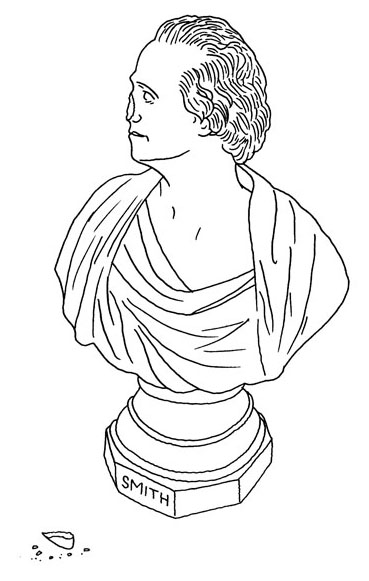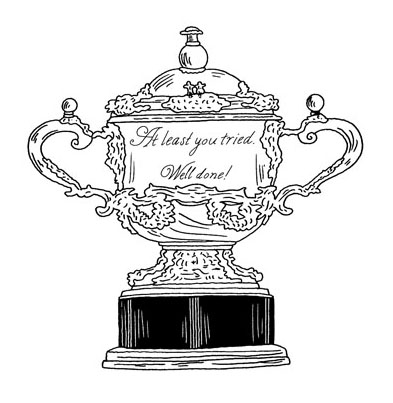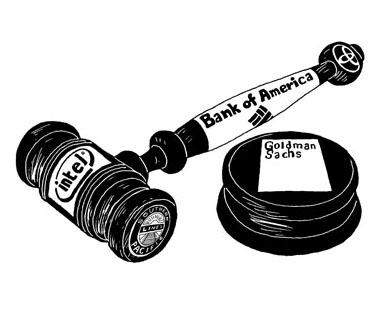
Rich People Things
With illustrations by Peter Arkle
"Social criticism at its scorching-hot best" —Barbara Ehrenreich
Buy This Book
|
Paperback: $17/£11
|
E-book: $10/£7
|
Print + E-book: $22/£14
|
About the Book
It’s never easy being rich: endless tax avoidance, the Sisyphean search for reliable domestic staff, the never-ending burden of surly stares from the Great Sea of the Unwashed as one goes about one’s rightful business. Toughest of all is simply keeping track of everything one owns. There’s so much of it. And personal possessions are just the beginning.

You must keep a gimlet eye, too, on the myriad people and institutions that safeguard your gilded status: politicians, newspapers, financial instruments, branches of government. They all belong to you. But staying on top of what they’re up to is a full time job. What’s an overstretched gazillionaire to do?
Now, with the publication of Rich People Things, the problems of our over-classes are, well, over. In a concise, easy-to-use guide, Chris Lehmann catalogs the fortifications that shelter the opulent from the resentments of the hoi polloi. From ideological stanchions such as the Free Market and the Prosperity Gospel, through the castellation of media, including The New York Times, Wired Magazine and Reality Television, to burly gatekeepers such as David Brooks, Steve Forbes and Alan Greenspan, the well-to-do will find, in these pages, a comforting and comprehensive array of the protections that allow them to sleep sound at night.
For the rest of us, Lehmann’s sparkling prose, at the same time pointed and whimsical, together with the clever, teasing illustrations of Peter Arkle, can at least provide a diverting glimpse into how the top one percent maintains an iron grip on almost half of America’s financial wealth.
“Since strange fate and television have transformed me from an ORDINARY WRITER into a DERANGED MILLIONAIRE, I can tell you that Chris Lehmann is NO ORDINARY WRITER. Indeed, he captures here, with rare and devastating wit, precisely why and how the rich (by which I mean: ME) are so different from me and you (by which I mean: YOU). If this book were plated in platinum and larded with a million designer labels, I WOULD BUY IT.” —John Hodgman
“What a delight it is to have—finally!—an entire book in which Chris Lehmann gives the mountebanks and plutocrats of this world the drubbing they deserve—in delicious detail and at satisfying length. His scoffing is a tonic.” —Tom Frank
“This book made me laugh and cry. And wish I were a plutocrat. Chris Lehmann is an amazing writer. I will read his books until i die.” —Gary Shteyngart
Publication October 15th 2010 • 248 pages • 27 black and white illustrations
paperback ISBN 978-1-935928-12-6 • ebook ISBN 978-1-935928-13-3
About the Author and Illustrator
 |
Chris Lehmann, like many a son of the benighted de-industrialized Midwest, has cobbled together a living as a casualized knowledge worker. He is employed, ever precariously, as an editor for Yahoo! News, BookForum and the Baffler, while dissecting the excesses of his social betters on a still-more marginal moonlighting basis for The Awl.com. He lives in Washington, DC, with his wife, Ana Marie Cox, and a quartet of excellent pets. |
 |
Peter Arkle lives in New York, where he’s a freelance illustrator of books, magazines and ads (his clients include at least a couple of the rich people’s things featured in this book). He occasionally publishes a newspaper, Peter Arkle News, containing stories and drawings about everyday life. |
In the Media
“The peculiar pathology of the rich and our oligarchic state” — RICH PEOPLE THINGS author Chris Lehmann interviewed by Chris Hedges for On Contact (November 26, 2021)
Slog, January 26th 2011
GRITv, December 3rd 2010
Reason TV, November 8th 2010
The Phoenix, November 2nd 2010
Mother Jones, October 18th 2010
Concurring Opinions, October 17th 2010
Talking Points Memo, October 6th 2010
bookforum.com, September 13th 2010
Mediaite.com, August 24th 2010
The Awl, August 20th 2010
TVrealist.com, August 20th 2010
Read an excerpt
Introduction
By Chris Lehmann
American class privilege is very much like the idea of sex in a Catholic
school—it’s not supposed to exist in the first place, but once it presents
itself in your mind’s eye, you realize that it’s everywhere. And as
with the upholders of adolescent propriety for the Mother Church,
the forces of repression in our political economy are well armed with
orthodox articles of faith. Social critics and academicians have expended
heroic amounts of ink to explain America’s “exceptionalist”
indifference to the distinctions of class—from the absence of a feudal
tradition to the frontier thesis to the convulsions of upward social
mobility across the generations. Scholars appealing to these forces
have all preached, in one way or another, that the condition of wage
earning in the New World is but a passing way station on the path to
real wealth and entitlement. Why, after all, should anyone militate on
behalf of the interests of an American working class when no one intends
to remain within its ranks for very long? And, conversely, why
should anyone insist there’s anything amiss with a society that lavishly
coddles those who are fabulously well-to-do when we all long to
be borne aloft in their company?
These are, to be sure, compelling explanations of our country’s
curiously complacent outlook on the politics of wealth and privilege—
but they also seem more than a little pat. Canada, after all, had
a western frontier and no strong attachment to feudal tradition, and
has nonetheless spawned a robust labor-led politics, a single-payer
health-care system, and a rather hale welfare state securing basic income
supports and social equality. Social mobility has of late been
higher in the allegedly fusty Old World social orders of Britain, Denmark,
and Sweden—places that can lay a far more legitimate claim
to the conservative epithet “socialist” than the business-friendly centrism
of the Obama Democratic policy elite—than in the deindustrializing,
debt-ridden United States.
If we’re to understand the stubborn resistance to the idea of social
class—especially in the wake of the Great Recession of 2008, which all
too plainly elevated the fortunes of the financial elite over the notional
prosperity of America’s declining middle orders—we’d do well to
relax our fealty to the ironclad determinism of past explanations. In
the spirit of the suggestible Catholic student, we should recur instead
to the piecemeal psychology of the absent presence—to look more
closely at the freestanding institutions that reinforce and strategically
update the coordinates of the reigning social consensus on economic
reward and punishment.
From this vantage, the lionization of wealth becomes less a fixed
catechism in the American creed than a contingent set of post hoc rationalizations—
attached here to the idea of undeviatingly gargantuan
executive compensation for the financial elite, and there to the business
press’s delusional romance with the ever-mythical free market.
Th is outlook has the advantage of making our state of chronic class
denial much less forbidding than it would be as a destiny-shaping
verdict handed down from our colonial past. But neither is that to
say that its social power is diluted by virtue of its comparative rootlessness.
Quite the contrary, in fact—the paper-thin and amnesiac
way that we continue to reckon with questions of wealth and power
accounts in large part for its staying power. Writing in 1956 of the
formative consensus that took shape on these issues during the Cold
War, C. Wright Mills observed that it hinged on a PR vision of elite
achievement, whereby liberals and conservatives alike found the
power elite “to be diversified to the point of powerlessness. So far as
power is concerned, nobody really makes decisions; let us fall back
upon official and formal images of representative government. So far
as wealth or high income is concerned, that is without decisive consequence,
although it does perhaps affect the tone of society at large.
Besides, everybody in America is rich nowadays. This unserious liberalism
is the nerve-center of the present-day conservative mood.”
That statement serves as a letter-perfect diagnosis of our socioeconomic
plight more than half a century later—save that it’s now
a tad harder for consensus thinkers to insist that every American is
rich. Nonetheless, it’s been striking to observe just how little the present
crisis has altered the basic terms of political engagement on all
sides. When the US economy veered toward cataclysm in the 1890s
and the 1930s, mass political movements registered a new national
distemper. The People’s Party of the late nineteenth century went so
far as to advocate an alternate production-based system of currency
and exchange, known as the Subtreasury, a reform that eventually
got watered down into the Free Silverite attack on the gold standard
when the party fused with the Democrats in 1896. And the thirties,
of course, witnessed the enactment of many of the core reforms first
advanced during the populist and Progressive eras——public ownership
of utilities, federally funded income support and retirement
plans, enormous national public works projects, and the like.
One might reasonably ask what it would take for the basic truths
of class division to sink in on today’s American scene, aft er the reckless
expansion of our paper economy has consigned entire productive
sectors of business enterprise into the dustbin of history; aft er the
bailed-out financier class continues to rack up obscene performance
bonuses on the government dime; after the securitization of debt has
left millions of American homes foreclosed, and millions more underwater.
Instead, we remain in thrall to an unserious liberalism that
continues to entrust most major economic policy decisions to career
investment bankers, and to a conservative movement rhetoric that
equates “populism” with heartland-approved consumption habits
and evangelical culture-wars posturing.
In this deeply incoherent state of affairs, it’s little wonder that conservatives
were able to oppose a stimulus plan that actually lowered
taxes for the vast majority of Americans by characterizing it as a feckless
big-government tax increase. Or that the anemic fi nal version
of health-care reform—larded with massive giveaways to the insurance
and pharmaceutical lobbies—can be widely depicted as a “government
takeover” of American medicine or, indeed, as full-blown
“socialism.” We appear to have descended to the point where political
economy, formerly the central organizing force in our national
politics, has become a floating signifier, intended to say more about
the demographic profile of individual political actors than anything
about the collective cast of our productive lives, and how the rewards
for our labor can be distributed more fairly and equitably.
Among other things, this state of affairs leaves leaders and policy
makers unable to offer coherent accounts of whom is meant to
benefit from efforts to revive and revamp our financial sector, our
rights to form unions, or our system of health care delivery. If such
incremental reforms come across in much of political discourse as
perverse and sweeping expressions of an undifferentiated liberal lust
for power, then prospects for meaningful change—truly nationalized
health care, finance overhauls that reward productive industry ahead
of speculation in the paper economy, dismantling of the savage inequalities
that still govern housing markets, and education funding—
seem like nothing more than utopian fantasy.
* * * *
When I began writing Rich People Things, I had nothing quite so
sweeping—or so dispiriting—in mind. Indeed, the whole thing came
about by accident. In early 2009, a couple of old laid-off editor friends
emailed me about a Web site they were launching (called the Awl,
for some reason) and invited me to contribute. At the time, I fi led
the idea pretty far back in my memory bank—especially since, as my
friends explained in their pitch letter, they’d be unable to pay their
writers. But a few weeks after the project launched, another friend directed
me to a cover story that ran in my former workplace, New York
magazine, itemizing the widespread sense of grievance and entitlement
among the city’s lords of finance in the wake of public outrage
over the Troubled Asset Relief Program’s no-strings giveaways to the
financial sector.
Since I knew all too well the inside-the-bubble mindset behind
this quisling dispatch from the money wars—the celebration of the
money culture being the de facto mission statement for Adam Moss’s
New York magazine—I knew I couldn’t stay quiet. And I also knew,
the deferential politics of the publishing world being what they are,
that whatever I wrote could only see the light of day at a place like
the Awl. So I wrote my friends, duly submitted a piece, and just as
it was about to go live, coeditor Alex Balk wrote to explain that his
colleague, Choire Sicha, “designed a graphic for this with the rubric,
‘Rich People Things.’ Does that work for you?” To which I replied,
‘um, sure?’ ” It was a fait accompli in any event, Alex replied, since
Choire had “gallivanted off to lunch”—though they could easily just
erase the rubric when he got back.
I don’t know when Choire returned, but by that time, we’d all
moved on to other things, and in the next week or so, I didn’t give
“Rich People Things” much thought, either as a column title or an ongoing
writing project. Thanks to another friend, though, I came across
another dispatch that showcased unthinking press fealty to economic
privilege—this time, a Washington Post front page piece about how
the Obama administration’s spending priorities would unduly punish
taxpayers earning more than $250,000 a year. This prospect, as the
Post correspondents saw it, could well place small-business owners
and upward-striving professionals—two plum political constituencies
that broke for Obama in 2008—at odds with the allegedly ambitious
social agenda of the fledgling Obama administration. As both
tax analysis and political kibitzing, the article reeked of horseshit—
especially since a number of the items on Obama’s ambitious social
agenda, such as federally backed health insurance, would significantly
aid the bottom lines for small-business entrepreneurs.
Once my eye had grown sufficiently jaundiced I started to see
material for the column everywhere—in lunatic manifestos from
Steve Forbes on corporate leadership and entire cover packages in
major newsweeklies addressing the future of work without containing
so much as a single passing mention of labor unions. Even though
the United States was enduring its worst economic crisis since the
Great Depression, our major outlets of opinion, most of the leadership
in Congress and the regulatory world, and nearly all the major
outlets of the business press were carrying on serenely as though
American society remained more a study in moneyed abandon than
abandoned money.
I fancy myself a fairly practiced cynic, but it struck me that my
randomly acquired beat was profoundly out of sync with the state of
the real economy, so much so that the familiar run of business coverage
and economic commentary started to strike my ear as exceedingly
strange. It all seemed not so much a hard-nosed appraisal of the
way the world really works as a species of magical incantation, worthy
of the witches in the opening scene of Macbeth. From the point of
view of my own journalistic production, this was a great boon; finding
suitable column fare was generally not much more arduous than
taking in a Money magazine feature on, say, the damage the downturn
had wrought on exclusive golf clubs, letting the outrage sink in,
and opening up a fresh Word document on the computer.
Slowly, though, it dawned on me that the odd pleasure of putting
the column together each week served as a footnote of sorts to the
more-or-less permanent character of these United States. The omission
of real economic conditions from the accounting of the republic’s
collective life was something that ran very deep—if also very diffusely—
in our history. Unbidden, long-dormant snatches of my graduate
history education started to tug at me and worked their way into the
margins of the column. It became starkly evident, for instance, that
one couldn’t snipe at Newsweek‘s saucer-eyed speculations about
whether the new generation of young workers would be unduly stingy
about floating more of their incomes into the consumer economy
in order to jumpstart still-skittish demand without also noting that
the last generation of deeply traumatized American savers—those
who came of working age during the Great Depression—had the assurance
of a robust public sector, a fairly militant labor movement,
and the informal social contract binding together business, labor, and
government in common aims of enterprise. All these factors helped
ensure that the wages of Depression-era wageworkers at least kept
pace with the inflationary pressures that came with economic growth,
once it finally arrived. All today’s young workers had, by contrast,
were the rancid leavings of the Reagan-inspired war on New Deal
social protections—together with the banker-friendly policy initiatives
of a craven “New Democrat” leadership on the other side of the
partisan aisle.
Rich People Things began life as an afterthought title for a column
without any particular mission statement to push it forward;
but I later realized that this pointedly dismissive phrase took in a
good many more trends, movements, and institutions than I’d fi rst
assumed. What were the US Constitution, the perpetual campaign and-
election season, the civic religion of celebrity worship, urban development
policies, and the cloistered state of high-literary debate, if
not also Rich People Things in their own right? Why not, then, widen
the aperture of my accidental column to take in more of the long view
of the American scene? This is not to advance, mind you, any overarching
materialist explanation of our past—strict economic determinism
isn’t an especially persuasive vision of history, and anything
but a lively one. Rather, it’s something infinitely more modest—an
effort to apply the roving one-hit methodology of an online column,
typically composed with the phrase, “Can you believe this shit?”
ringing in my ears, to somewhat sturdier features of our common life.
In the impressionistic tract that follows, I’ve occasionally cannibalized
my other published work, both in the Awl and elsewhere, as it
pertains to the expanding Rich People Things waterfront, but mainly
I’ve just sought to imagine how the writing persona I’ve developed in
the post-meltdown aughts would be provoked, baffled, and generally
trigger happy if the Doc’s time machine plunked him back down in
the US history colloquia that formed the backbone of his long-ago
graduate instruction. It’s been cathartic, if nothing else, and I trust
that you, dear reader, might find a similar tonic effect in these wayward
musings.
View Sample Illustrations
Original illustrations for Rich People Things
By Peter Arkle
Free Market

Meritocracy

Supreme Court

WIRED Magazine






